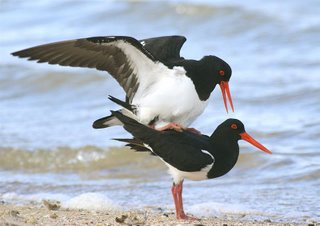Well Fed Pied Oystercatchers
 On a day that looked less than promising, I made an early morning visit to Pipeclay Lagoon. By the oyster sheds there are 2 pairs of Pied Oystercatchers that have become very tolerant of human presence, and one pair (pictured) is regularly fed oysters by the staff there. I'm sure I could make some remark about the aphrodisiac properties of oysters, but as I stopped the car to observe this pair, as you can see, they copulated. I have always thought that the shots that I've seen of Oystercatchers copulating,
On a day that looked less than promising, I made an early morning visit to Pipeclay Lagoon. By the oyster sheds there are 2 pairs of Pied Oystercatchers that have become very tolerant of human presence, and one pair (pictured) is regularly fed oysters by the staff there. I'm sure I could make some remark about the aphrodisiac properties of oysters, but as I stopped the car to observe this pair, as you can see, they copulated. I have always thought that the shots that I've seen of Oystercatchers copulating,  must have been the result of many hours watching and waiting! Maybe not. With rain threatening, I decided to drive on to South Arm, and walked through the dunes to Calvert's Beach. As I reached the top of the dune, I saw below me, the seal on the waters' edge that is pictured here. I assume it's an Australian Fur Seal, but perhaps there's someone reading this who can confirm that. A more rewarding morning than appeared likely.
must have been the result of many hours watching and waiting! Maybe not. With rain threatening, I decided to drive on to South Arm, and walked through the dunes to Calvert's Beach. As I reached the top of the dune, I saw below me, the seal on the waters' edge that is pictured here. I assume it's an Australian Fur Seal, but perhaps there's someone reading this who can confirm that. A more rewarding morning than appeared likely.
 On a day that looked less than promising, I made an early morning visit to Pipeclay Lagoon. By the oyster sheds there are 2 pairs of Pied Oystercatchers that have become very tolerant of human presence, and one pair (pictured) is regularly fed oysters by the staff there. I'm sure I could make some remark about the aphrodisiac properties of oysters, but as I stopped the car to observe this pair, as you can see, they copulated. I have always thought that the shots that I've seen of Oystercatchers copulating,
On a day that looked less than promising, I made an early morning visit to Pipeclay Lagoon. By the oyster sheds there are 2 pairs of Pied Oystercatchers that have become very tolerant of human presence, and one pair (pictured) is regularly fed oysters by the staff there. I'm sure I could make some remark about the aphrodisiac properties of oysters, but as I stopped the car to observe this pair, as you can see, they copulated. I have always thought that the shots that I've seen of Oystercatchers copulating,  must have been the result of many hours watching and waiting! Maybe not. With rain threatening, I decided to drive on to South Arm, and walked through the dunes to Calvert's Beach. As I reached the top of the dune, I saw below me, the seal on the waters' edge that is pictured here. I assume it's an Australian Fur Seal, but perhaps there's someone reading this who can confirm that. A more rewarding morning than appeared likely.
must have been the result of many hours watching and waiting! Maybe not. With rain threatening, I decided to drive on to South Arm, and walked through the dunes to Calvert's Beach. As I reached the top of the dune, I saw below me, the seal on the waters' edge that is pictured here. I assume it's an Australian Fur Seal, but perhaps there's someone reading this who can confirm that. A more rewarding morning than appeared likely.
4 comments:
I don't know whether this shot is demonstrative of other pairs of Pied Oystercatchers but there seems to be a significant difference in the extent of the black on the breast, the female (bottom) having more than the male.
I don't have the luxury of being able to go out and have a look but a quick search on the internet turned up a couple of other pairs that also seem to indicate a marked difference.
I wonder how practical it may be (or not) to use this as a way of telling the sexes apart???
Hi Matthew,
A quick look at HANZAB doesn't suggest any difference in plumages between the sexes in POs. But a look at other shots, including a photo in the Photographic Index, also suggests a difference. It's hard to believe that it wouldn't have been noticed before, but I'll look a little closer in future.
We've offered to help with the ongoing Ralph's Bay surveys - in light of the Marina Proposal - and so will also keep an eye out for any consistent differences.
When being given some tips about Waders the other day, on preparation for helping with the surveys (we're much better on bush birds), we were told there are slight differences in bill length and colouration between the sexes, but nothing was said about the 'bib' size.
I seem to recall that at one time, there was a theory going round that the sexes could be told by the shape of their bill. That is, chisel ended or pointed. As both of the birds in the photo appear to have pointed bills, I assume that theory no longer holds true!
Post a Comment